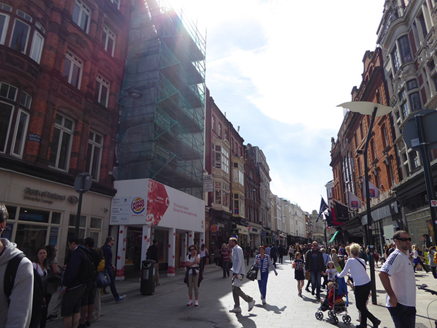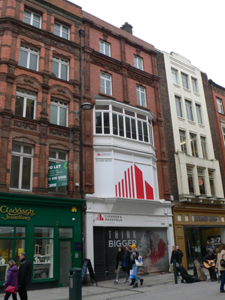Survey Data
Reg No
50100003
Rating
Regional
Categories of Special Interest
Architectural, Artistic
Previous Name
FitzHenry
Original Use
Shop/retail outlet
In Use As
Shop/retail outlet
Date
1930 - 1940
Coordinates
315993, 233919
Date Recorded
24/08/2016
Date Updated
--/--/--
Description
Attached two-bay five-storey commercial building, built c. 1935, with timber shopfront to ground floor, and full-height gabled return to rear. Under renovation in August 2016. Pitched roof, hipped to north, concealed by brick parapet with moulded masonry coping, and with concealed rainwater goods. Flemish bond red brick walling, having engaged red sandstone pilasters to outer edges of each floor, having roundels to frieze level and extending from first floor to deep red sandstone cornices over third and fourth floors, cornice to third floor having frieze beneath with foliate carvings. Central panelled pilasters dividing bays to upper floors. Square-headed window openings, with projecting red sandstone keystones and sills to upper floors with bipartite timber casement windows; two-tier canted oriel window to first and second floors, having panelled aprons, continuous moulded timber cornices and sills; fixed-light windows to first floor with bottom-pivoted overlights; and bipartite casements to second floor. Shopfront retains moulded cornice with dentils, and plain frieze intersected by angled apron of oriel window.
Appraisal
No. 3 Grafton Street is a worthy inter-war red brick commercial building, with characteristic frame construction, a two-tier canted oriel bay window and red sandstone detailing. The building appears to be well retained, with some original shopfront detailing to the ground floor. Complementing the style, materials and proportions of the adjoining No. 2 Grafton Street to the north, the two create a fairly cohesive frontage to the northern entrance to Grafton Street, contributing to the architectural vitality and eclecticism of the street. Grafton Street was initially developed in the early eighteenth century, but was largely rebuilt at the end of that century, while widening and further rebuilding were initiated by the Wide Streets Commissioners in 1841. By the mid-Victorian period the street was largely commercial and experienced spates of building activity during the late nineteenth and early twentieth centuries. Now celebrated as Dublin's premier retail street, its architectural character is distinctly varied.



